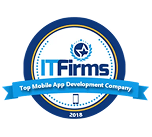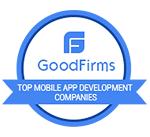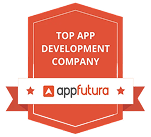Top 10 Trends in AI and Development to Watch at GITEX 2025
The technology landscape is evolving at breakneck speed, and there’s no better place to witness this transformation than GITEX Global 2025. As we stand on the cusp of a new era in artificial intelligence and app development, the question isn’t whether your business should adopt these technologies—it’s how quickly you can implement them before your competitors do. This comprehensive guide will walk you through the most groundbreaking trends that are reshaping the digital economy, and more importantly, show you how to turn these innovations into tangible business results.
Why is GITEX Global 2025 the Ultimate Technology Destination?
The Global Epicenter of Tech Innovation
Picture this: over 6,000 companies from 170+ countries converging in Dubai, all under one roof, showcasing technologies that will define the next decade. That’s GITEX Global 2025 for you. Unlike typical tech conferences where ideas remain theoretical, GITEX is where innovation becomes reality. It’s not just an exhibition—it’s a living laboratory where you can touch, test, and deploy solutions that solve real business problems.
Dubai has strategically positioned itself as the global hub for digital transformation, with government initiatives pouring billions into AI infrastructure and smart city projects. This creates a unique ecosystem where startups, enterprises, and governments collaborate to accelerate innovation at an unprecedented pace.
Numbers That Speak Volumes
Let’s talk about facts. According to PwC’s Middle East Economic Report, AI could contribute up to 14% of the UAE’s GDP by 2030, translating to approximately $96 billion in economic value. Similarly, McKinsey’s research suggests that AI technologies could unlock $150 billion annually across GCC economies by 2030, with generative AI adding another $21-35 billion to that figure.
| GITEX 2025 Statistics | Numbers |
|---|---|
| Participating Companies | 6,000+ |
| Countries Represented | 170+ |
| Expected Visitors | 180,000+ |
| Startup Exhibitors | 1,500+ |
| Investment Deals (Projected) | $15+ Billion |
What Makes GITEX 2025 Different?
Here’s what sets GITEX apart from other technology events: it’s not about what might happen in five years. It’s about what you can implement tomorrow. Whether you’re exploring AI agents for customer service, evaluating edge computing infrastructure, or seeking partners for blockchain integration, GITEX provides direct access to solution providers, live demonstrations, and proof-of-concept opportunities that compress months of research into five focused days.
Also Read – Launch a Loan Lending App MVP: Affordable Steps to Validate Your Idea
10 Emerging App Development Trends to Watch at GITEX 2025
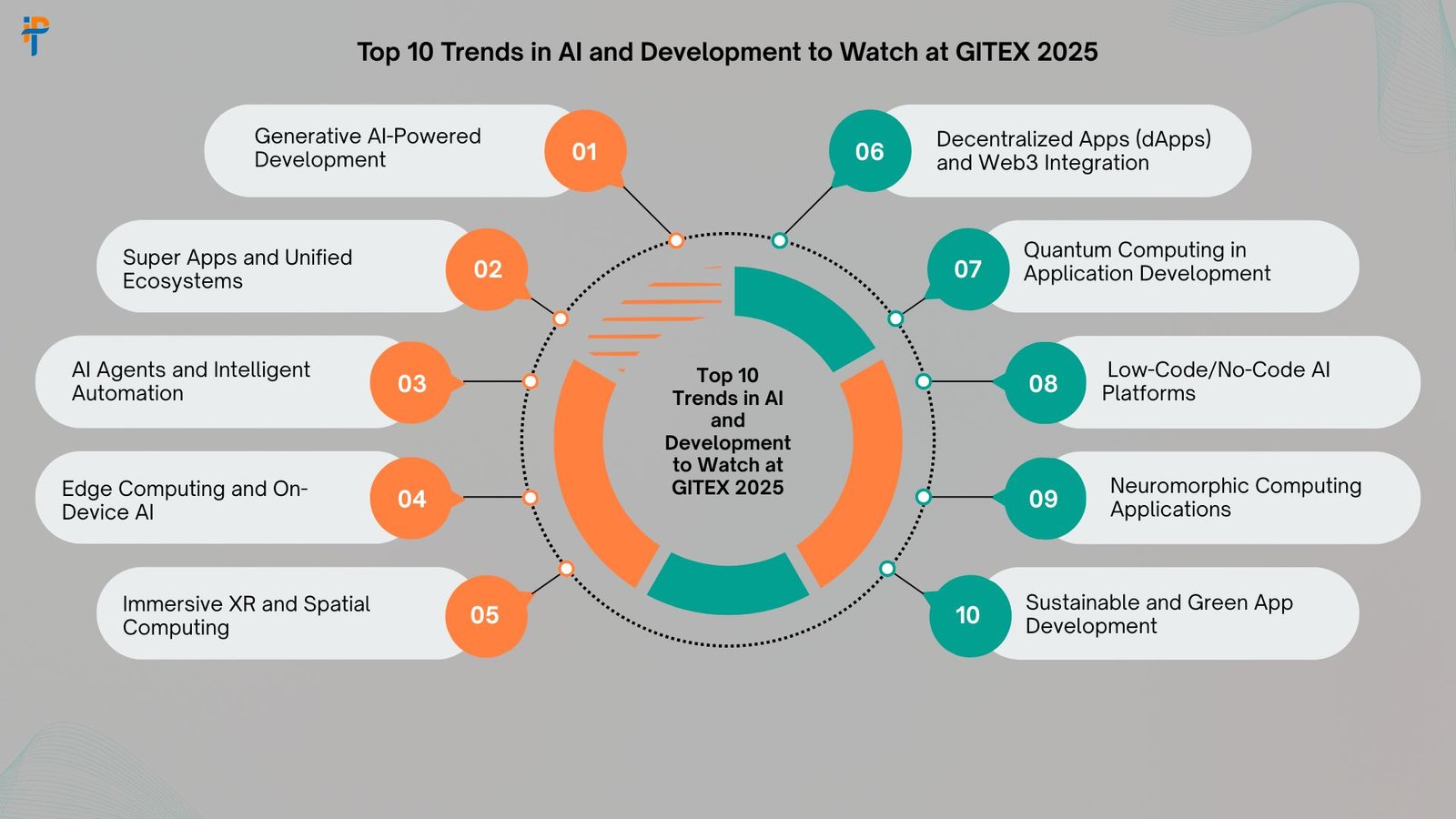
1. Generative AI-Powered Development
Generative AI has moved far beyond ChatGPT. At GITEX 2025, you’ll witness how AI is fundamentally changing software development itself. Developers are now partnering with AI assistants that write code, design user interfaces, generate test cases, and even debug applications in real-time. According to GitHub’s State of the Octoverse report, developers using AI coding assistants are 55% more productive, completing tasks up to twice as fast.
What does this mean for your business? Reduced development costs, faster time-to-market, and the ability to iterate on ideas without massive upfront investment. Imagine prototyping a new application in days instead of months—that’s the power of generative AI in development.
2. Super Apps and Unified Ecosystems
The era of single-purpose applications is ending. Super apps—comprehensive platforms that combine payments, social interaction, commerce, logistics, and entertainment—are becoming the new standard. Think of WeChat in China or Grab in Southeast Asia, but now expanding globally with even more sophisticated features.
For businesses, this trend presents a crucial decision: should you build your own super app ecosystem, or integrate your services into existing platforms? GITEX 2025 will showcase both approaches, with live demonstrations of modular architectures that make integration seamless.
3. AI Agents and Intelligent Automation
Move over, chatbots—AI agents are here. These aren’t simple rule-based systems; they’re intelligent entities that can understand context, make decisions, learn from interactions, and execute complex multi-step workflows autonomously. From scheduling meetings and managing customer inquiries to processing insurance claims and conducting financial analysis, AI agents are becoming the digital workforce of tomorrow.
The difference? Traditional automation follows scripts. AI agents adapt to situations, handle exceptions, and improve over time without human intervention.
4. Edge Computing and On-Device AI
Why send data to the cloud when you can process it right where it’s created? Edge computing brings computational power closer to data sources, dramatically reducing latency and enhancing privacy. Combined with on-device AI, this enables applications to run complex machine learning models directly on smartphones, IoT devices, and edge servers.
This trend is particularly transformative for industries requiring real-time responses: autonomous vehicles processing sensor data in milliseconds, healthcare devices analyzing patient vitals instantly, or retail systems providing personalized recommendations without internet connectivity.
5. Immersive XR and Spatial Computing
Extended Reality (XR)—encompassing augmented reality (AR), virtual reality (VR), and mixed reality (MR)—is finally crossing the chasm from experimental to essential. Apple’s Vision Pro and Meta’s Quest headsets have demonstrated that spatial computing isn’t science fiction; it’s the next computing platform.
At GITEX 2025, expect to see XR applications that go beyond gaming: virtual showrooms where customers examine products in 3D, immersive training programs that reduce workplace accidents by 70%, and collaborative workspaces where remote teams feel physically present together.
6. Decentralized Apps (dApps) and Web3 Integration
Blockchain technology has matured beyond cryptocurrency speculation. Decentralized applications (dApps) are now solving real business problems: supply chain transparency, digital identity verification, royalty distribution for creators, and transparent governance systems.
The key advantage? Trust without intermediaries. In industries plagued by fraud or requiring transparent audits—finance, healthcare, logistics, intellectual property—blockchain-based applications are becoming the preferred solution.
7. Quantum Computing in Application Development
While large-scale quantum computers remain years away from mainstream adoption, quantum-inspired algorithms are already being integrated into classical applications. These algorithms can optimize complex logistics networks, accelerate drug discovery, enhance cryptographic security, and solve problems that would take traditional computers years to process.
GITEX 2025 will feature quantum computing companies demonstrating hybrid quantum-classical systems that businesses can access via cloud services today, not tomorrow.
8. Low-Code/No-Code AI Platforms
Not every business can afford a team of data scientists and machine learning engineers. That’s where low-code and no-code AI platforms come in, democratizing artificial intelligence for non-technical users. These platforms allow business analysts, product managers, and domain experts to build sophisticated AI applications using visual interfaces and pre-trained models.
According to Gartner’s forecast, by 2026, developers outside formal IT departments will account for at least 80% of the user base for low-code development tools—a clear indication that citizen developers are becoming a force to reckon with.
9. Neuromorphic Computing Applications
Inspired by the human brain’s architecture, neuromorphic computing chips process information fundamentally differently than traditional processors. They excel at pattern recognition, sensor processing, and energy-efficient AI inference—making them ideal for edge devices, robotics, and autonomous systems.
While still emerging, companies like Intel (with Loihi chips) and IBM (with TrueNorth) are pushing neuromorphic computing from research labs into commercial applications. GITEX 2025 will showcase early adopters implementing these brain-inspired chips for real-world use cases.
10. Sustainable and Green App Development
Sustainability isn’t just a buzzword—it’s becoming a competitive requirement. Green app development focuses on energy-efficient code, carbon-aware cloud deployments, optimized data transfers, and resource-conscious architectures.
Here’s a surprising fact: data centers consume approximately 1-1.5% of global electricity, according to the International Energy Agency. As applications scale globally, their carbon footprint becomes significant. GITEX 2025 will feature tools and frameworks that help developers measure and minimize their applications’ environmental impact—turning sustainability into a measurable KPI.
| App Development Trend | Primary Benefit | Industries Leading Adoption |
|---|---|---|
| Generative AI Development | 55% faster development cycles | Technology, Finance, Healthcare |
| Super Apps | Unified user experience | Retail, Banking, Transportation |
| AI Agents | 70% reduction in operational costs | Customer Service, Insurance, HR |
| Edge Computing | 10x faster response times | IoT, Automotive, Manufacturing |
| XR & Spatial Computing | 40% improvement in training effectiveness | Education, Real Estate, Healthcare |
| Web3 & dApps | 100% transaction transparency | Supply Chain, Finance, Media |
| Quantum-Inspired Algorithms | Solutions to previously unsolvable problems | Logistics, Pharmaceuticals, Finance |
| Low-Code/No-Code AI | 80% faster deployment | SMBs, Marketing, Operations |
| Neuromorphic Computing | 100x energy efficiency | Robotics, IoT, Autonomous Systems |
| Green Development | 30% reduction in cloud costs | All industries with ESG commitments |
The Rise of AI-First Development: Transforming GITEX 2025
Why AI is No Longer Optional
Let me ask you this: would you hire an accountant who refuses to use spreadsheets? Probably not. Similarly, in 2025, building applications without AI integration is like developing software without databases—technically possible, but strategically foolish.
AI-first development means architecting applications from the ground up with artificial intelligence as a core component, not an afterthought. This approach enables applications that learn from user behavior, predict needs before they arise, automate routine decisions, and continuously improve without manual updates.
Machine Learning Infrastructure at Scale
The infrastructure powering AI has become as important as the algorithms themselves. GITEX 2025 will showcase next-generation ML infrastructure that addresses the biggest challenges organizations face: data pipeline management, model versioning, training at scale, deployment automation, and performance monitoring.
Companies like IPH Technologies have spent years building robust ML infrastructure that allows businesses to move from experimentation to production-grade AI applications in weeks instead of months.
Also Read – Top 15 Benefits of IT Staff Augmentation for Startups & Enterprises in 2025
Robotic Process Automation (RPA): Streamlining Business Processes
How RPA is Revolutionizing Operations
Robotic Process Automation has evolved from simple task automation to intelligent process orchestration. Modern RPA systems don’t just follow rules—they understand context, handle exceptions, and learn from human feedback.
Consider this scenario: A typical insurance claim requires data extraction from multiple sources, verification against policies, fraud detection screening, approval routing, and payment processing. Traditionally, this involves 5-7 different systems and multiple human touchpoints. With intelligent RPA, the entire workflow happens autonomously in minutes, with humans involved only for edge cases requiring judgment.
RPA Integration with AI and ML
The real magic happens when you combine RPA with artificial intelligence and machine learning. This creates “intelligent automation” that can:
- Process unstructured data (emails, PDFs, images) using natural language processing
- Make decisions based on patterns learned from historical data
- Adapt to process variations without requiring reprogramming
- Predict process bottlenecks and optimize workflows proactively
Real-World RPA Applications
At IPH Technologies, we’ve implemented RPA solutions across diverse industries with measurable impact:
Finance & Banking: Automated loan processing systems that reduced approval time from 5 days to 4 hours while improving accuracy by 94%.
Healthcare: Patient data reconciliation systems that process 50,000+ records daily with 99.7% accuracy, freeing clinical staff to focus on patient care.
Retail: Inventory management automation that predicts stock requirements 30 days in advance, reducing overstock by 35% and stockouts by 62%.
Manufacturing: Quality control systems that inspect products in real-time, detecting defects with 99.2% accuracy—better than human inspectors working in optimal conditions.
Beyond the Buzzwords – Real-World Impact
From Concept to Implementation
Here’s the uncomfortable truth about technology conferences: they’re often heavy on hype and light on execution. Vendors showcase impressive demos that fall apart in production. Startups promise revolutionary solutions that never ship. Consultants sell transformation without understanding your business constraints.
GITEX 2025 is different because it focuses on technologies that are production-ready today. These aren’t lab experiments or conceptual frameworks—they’re solutions being deployed at scale by real businesses solving actual problems.
Measurable Business Outcomes
Technology for technology’s sake is expensive theater. What matters are outcomes: increased revenue, reduced costs, improved customer satisfaction, faster time-to-market, and competitive advantage.
Let’s look at some real numbers from businesses that have implemented the trends we’ve discussed:
- Generative AI: A financial services company reduced custom report generation time from 4 hours to 12 minutes—a 95% improvement.
- Edge Computing: A logistics provider cut last-mile delivery costs by 18% through real-time route optimization processed at the edge.
- RPA + AI: An insurance company decreased claims processing time by 67% while improving fraud detection rates by 43%.
- XR Training: A manufacturing firm reduced workplace accidents by 52% after implementing immersive safety training.
These aren’t projections or theoretical benefits—they’re actual results achieved by businesses that moved decisively on emerging technologies.
How IPH Technologies Transforms GITEX Trends into Client Success Stories
At IPH Technologies, we’ve spent a decade turning cutting-edge trends into business-critical solutions. With over 500 successful projects, 430+ satisfied clients, and 284+ positive reviews on Clutch, we don’t just follow trends—we’ve often implemented them before they became mainstream. Let me share three examples that demonstrate our approach.
Case Study 1: Healthcare Digital Transformation
The Challenge: A regional healthcare network with 12 hospitals struggled with patient data scattered across incompatible systems. Doctors couldn’t access complete patient histories. Appointment scheduling was chaos. Lab results often got lost in administrative workflows.
Our Solution: We implemented a comprehensive AI-powered patient data platform that:
- Unified data from 47 different legacy systems into a single, real-time view
- Deployed natural language processing to extract insights from unstructured clinical notes
- Created an intelligent appointment system that reduced wait times by 43%
- Implemented edge computing for medical devices, enabling real-time vital sign monitoring
The Results:
- Patient data access time reduced from 12 minutes to 8 seconds
- Administrative costs decreased by 31%
- Patient satisfaction scores improved by 38%
- The system now processes 18000+ patient interactions daily
Case Study 2: Fintech Innovation
The Challenge: A growing fintech startup wanted to expand into Middle Eastern markets but faced regulatory compliance challenges, high transaction costs, and customer acquisition difficulties.
Our Solution: We developed a comprehensive digital banking platform featuring:
- AI-driven KYC (Know Your Customer) automation that reduced onboarding from 3 days to 14 minutes
- Blockchain-based transaction ledger ensuring regulatory compliance across 6 jurisdictions
- Generative AI chatbot handling 78% of customer inquiries without human intervention
- Predictive analytics for fraud detection, catching suspicious transactions before they complete
The Results:
- Successfully launched in 4 new markets within 7 months
- Transaction costs reduced by 54%
- Customer acquisition cost dropped by 41%
- Zero compliance violations in 18 months of operation
- Platform now processes $120M+ in transactions monthly
Case Study 3: Retail Experience Revolution
The Challenge: A luxury retail chain with 85 stores across the GCC faced declining foot traffic, increasing customer acquisition costs, and intense competition from e-commerce giants.
Our Solution: We created an omnichannel retail experience platform combining:
- AR-powered virtual try-on capabilities integrated with the mobile app
- AI-driven personalized product recommendations are increasing average order value
- Edge computing-enabled smart mirrors in fitting rooms showing complementary items
- RPA-automated inventory management synced across online and physical channels
The Results:
- In-store conversion rates increased by 67%
- Average basket size grew by 52%
- Inventory carrying costs reduced by 28%
- Customer lifetime value increased by 91%
- Online-to-offline traffic improved by 134%
These aren’t cherry-picked success stories—they represent our standard approach: understand the business problem, apply the right technology (whether it’s trending or not), measure results ruthlessly, and iterate until we exceed targets.
Industry-Specific Innovation Spotlight: Tailored Solutions for Your Sector
Not all industries benefit equally from every technology trend. What transforms healthcare might be irrelevant for logistics. What revolutionizes retail might not work in manufacturing. Here’s how GITEX 2025 trends apply to specific sectors:
Healthcare and Life Sciences
The healthcare industry is experiencing its most significant transformation since the introduction of electronic health records. Key technologies making impact:
AI-Powered Diagnostics: Machine learning models now detect certain cancers, cardiovascular conditions, and retinal diseases with accuracy matching or exceeding specialist physicians.
Telemedicine 2.0: Beyond simple video consultations, next-generation telehealth platforms use edge computing for real-time vital sign monitoring, AI for preliminary diagnosis, and XR for remote surgical guidance.
Drug Discovery Acceleration: Quantum-inspired algorithms and generative AI are reducing drug discovery timelines from 10+ years to 3-4 years, with significantly lower costs.
Patient Data Security: Blockchain-based health records ensure data sovereignty while enabling secure sharing across providers, solving the interoperability nightmare that has plagued healthcare for decades.
Financial Services and Fintech
Financial services are being rebuilt from first principles using technologies that enable new business models:
Embedded Finance: APIs and microservices architectures allow non-financial companies to offer banking services, creating super app ecosystems where finance becomes invisible but ubiquitous.
Real-Time Risk Assessment: Edge computing enables loan decisions in seconds, not days, by processing creditworthiness calculations at the point of application.
Fraud Detection 3.0: AI agents continuously monitor transaction patterns across millions of users, detecting sophisticated fraud schemes that traditional rule-based systems miss entirely.
Regulatory Technology (RegTech): RPA combined with AI ensures continuous compliance monitoring, automatically adapting to regulatory changes across multiple jurisdictions.
Retail and E-Commerce
Retail is being reimagined as the boundary between physical and digital experiences dissolves:
Hyper-Personalization: Generative AI creates unique shopping experiences for each customer, from personalized product recommendations to customized marketing content.
Inventory Intelligence: Machine learning predicts demand with unprecedented accuracy, reducing both overstock waste and lost sales from stockouts.
Immersive Shopping: XR technologies enable customers to visualize furniture in their homes, try on clothes virtually, or explore products in 3D before purchasing.
Sustainable Supply Chains: Blockchain provides complete transparency from raw materials to final delivery, allowing consumers to verify sustainability claims.
Logistics and Supply Chain
Supply chain disruptions during recent years proved that traditional logistics approaches are inadequate for modern complexity:
Predictive Logistics: AI analyzes weather, traffic, political events, and thousands of other variables to optimize routing and predict disruptions before they occur.
Autonomous Warehousing: Robots powered by edge computing and on-device AI handle picking, packing, and inventory management with 99.9% accuracy.
Smart Containers: IoT sensors combined with edge computing provide real-time location, condition monitoring, and predictive maintenance for shipping containers.
Blockchain Provenance: Complete supply chain visibility from manufacturer to consumer, eliminating counterfeits and ensuring authenticity.
Manufacturing and IoT
Industry 4.0 is transitioning to Industry 5.0, where humans and intelligent machines collaborate seamlessly:
Predictive Maintenance: Edge AI analyzes vibration, temperature, and sound patterns from machinery, predicting failures days or weeks before they occur.
Digital Twins: Virtual replicas of physical production lines allow manufacturers to test changes, optimize processes, and train staff in risk-free environments.
Quality Control Automation: Computer vision systems inspect products at speeds and accuracy levels impossible for human inspectors.
Energy Optimization: AI-driven systems reduce manufacturing energy consumption by 25-35% while maintaining or improving production output.
Why Connect with IPH Technologies
Our Decade of Innovation
Since our founding, IPH Technologies has been guided by a simple philosophy: technology should solve problems, not create them. Over the past ten years, we’ve developed this philosophy into a proven methodology that has delivered success across 500+ projects.
What makes us different? We don’t chase trends—we evaluate technologies based on business impact. We don’t sell solutions—we build partnerships. We don’t promise transformation—we deliver measurable results.
Our track record speaks clearly:
- 500+ successful projects across 15 industries
- 430+ satisfied clients ranging from startups to Fortune 500 companies
- 284+ positive reviews on Clutch, averaging 4.9/5 stars
- 10 years of continuous innovation and client success
- 95% client retention rate, with most clients engaging us for multiple projects


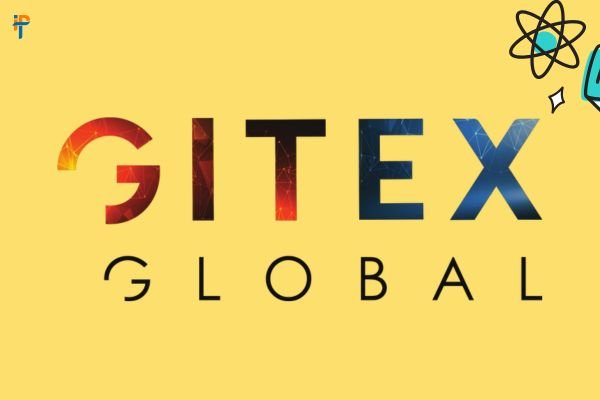











.png)
